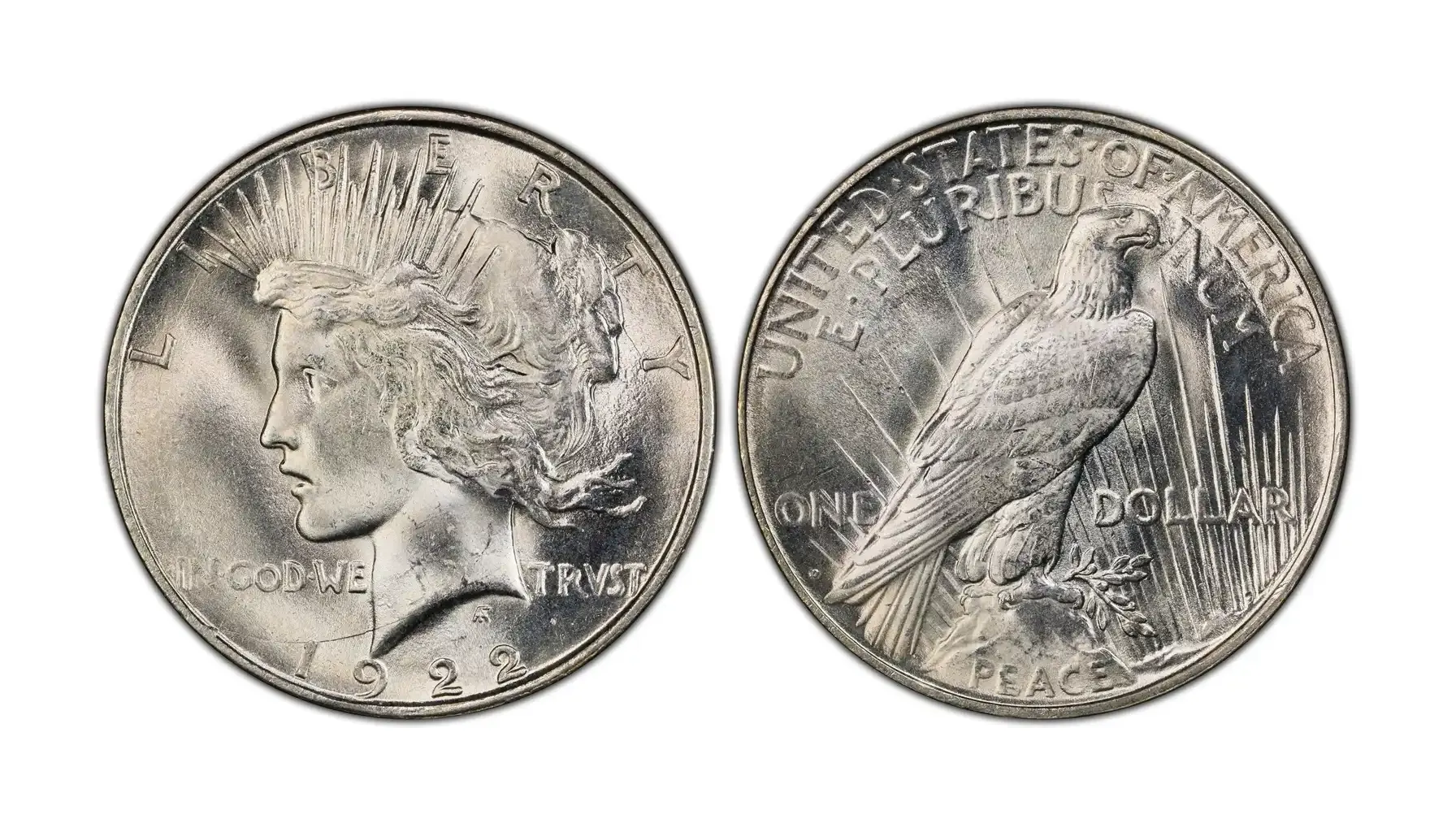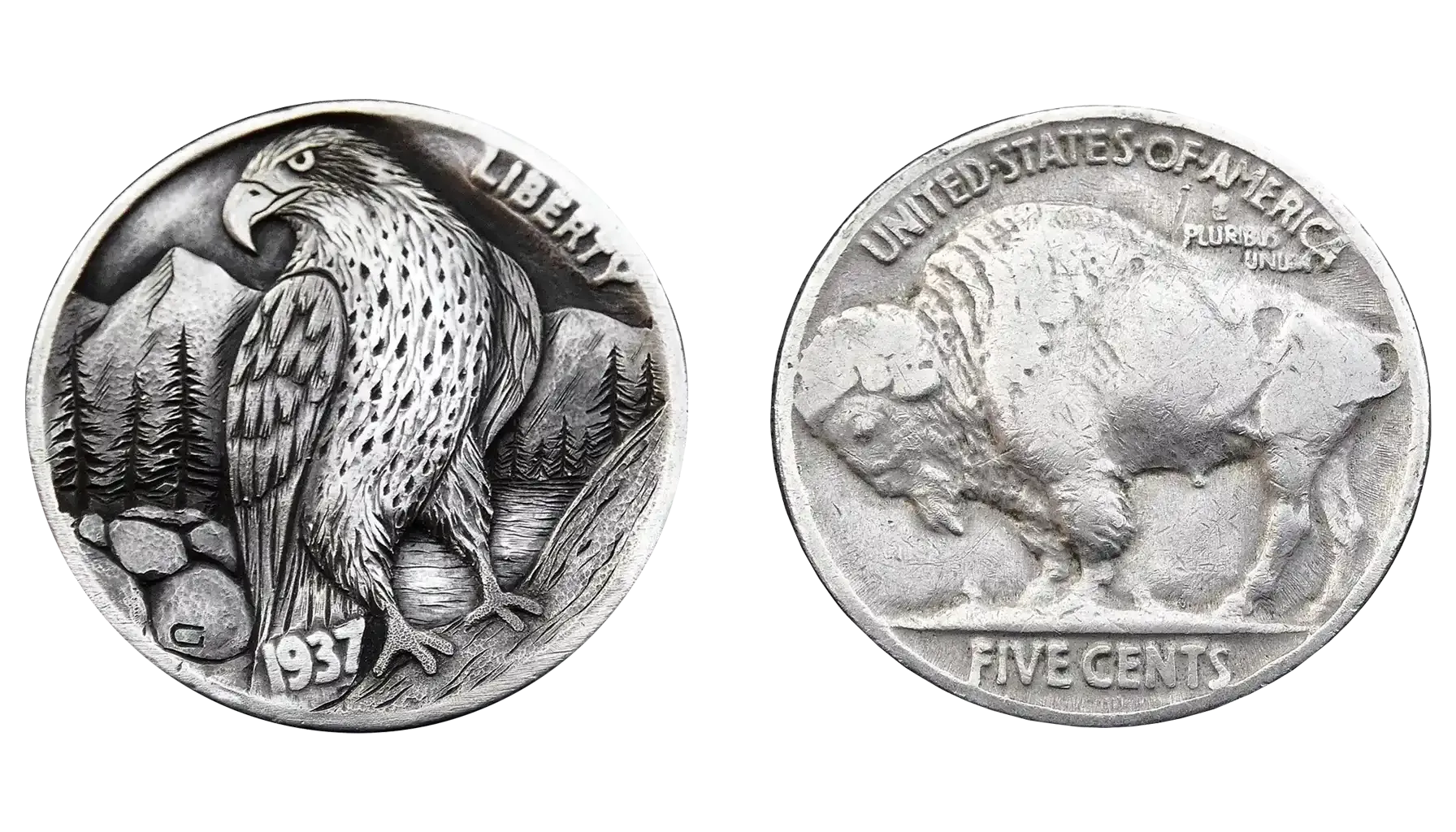Contents:
The 1970 Jefferson nickel looks like any other five-cent coin, but fans know it's not that simple. Many coins from this year are still in circulation and are worth their face value. However, some can be worth a lot more, especially if they are in perfect shape or have rare mint errors. The reverse side still proudly features the Latin motto “E Pluribus Unum”, a timeless phrase found on most U.S. coinage that signifies unity in diversity.
The 1970 nickel, which was made during a time of change for U.S. coins, is a favorite among both new and experienced collectors. Its classic design, which includes Thomas Jefferson and Monticello, hasn't changed in decades, which adds to its historical appeal. The original artwork was created by sculptor Felix Schlag, whose design has become a lasting symbol in American numismatics.
When evaluating a 1970 nickel, small details can make a big difference — including the mint mark location, condition of the coin, and presence of error varieties. Coins minted in San Francisco or Denver may carry subtle traits that affect market value. Since not every coin is created equal, relying on tools that help verify authenticity and grade can save time and money. A trusted coin value identifier makes it easier to spot potential hidden gems in your collection.
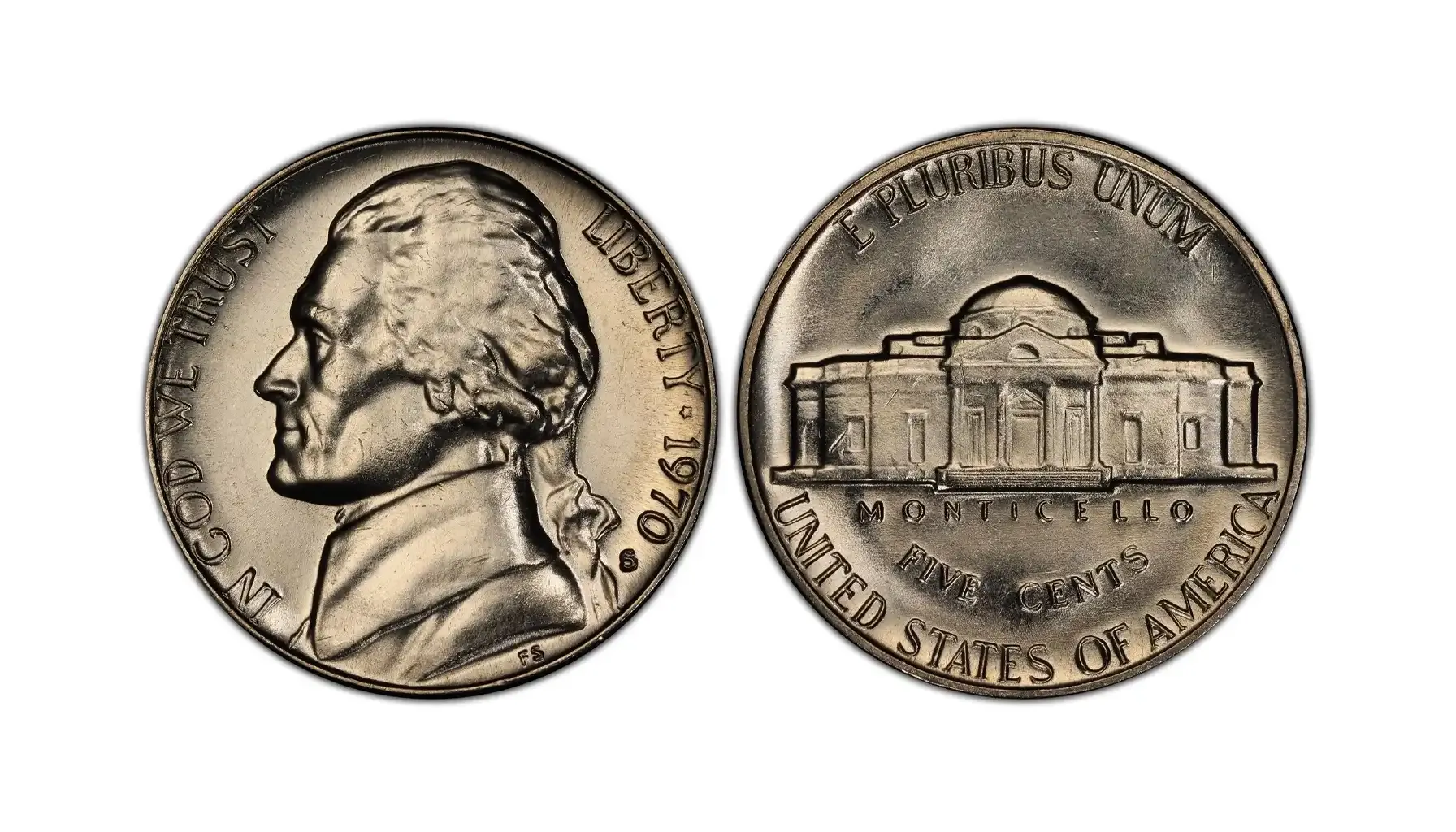
Overview of 1970 Nickels and Mint Marks
The 1970 nickel value can vary significantly based on the coin's condition, mint origin, and rarity. While most 1970 nickels found in circulation today are worth five cents, certain varieties can command much higher prices. Coin collectors usually like new coins or coins with lots of features, especially if the back of the coin shows full steps on Monticello. To figure out why one is more important than another, you must first know where and how it was made.
A standout among these coins is the 1970 S mint mark nickel, which was struck at the San Francisco Mint. Unlike circulation coins, these were typically issued as proofs—high-quality examples meant for collectors. The "S" mint mark, which is right next to Jefferson's shoulder on the front, makes them easy to spot. Many of them were rated as Cameo or Deep Cameo because they had a sharp strike and shiny surfaces. High-grade proof coins with these designations can reach significantly higher prices in today's collector market.
Meanwhile, the 1970 D mint mark appears on coins minted in Denver and intended for general use. These are far more common than their San Francisco counterparts but can still be worth collecting if they are in pristine condition. Coins from Denver that show the Full Steps designation—meaning the steps on Monticello are clearly defined—are especially desirable. The strength and precision of the strike matter greatly, and resources like this Jefferson Nickels value guide help collectors and grading services distinguish these higher-tier coins from the rest.
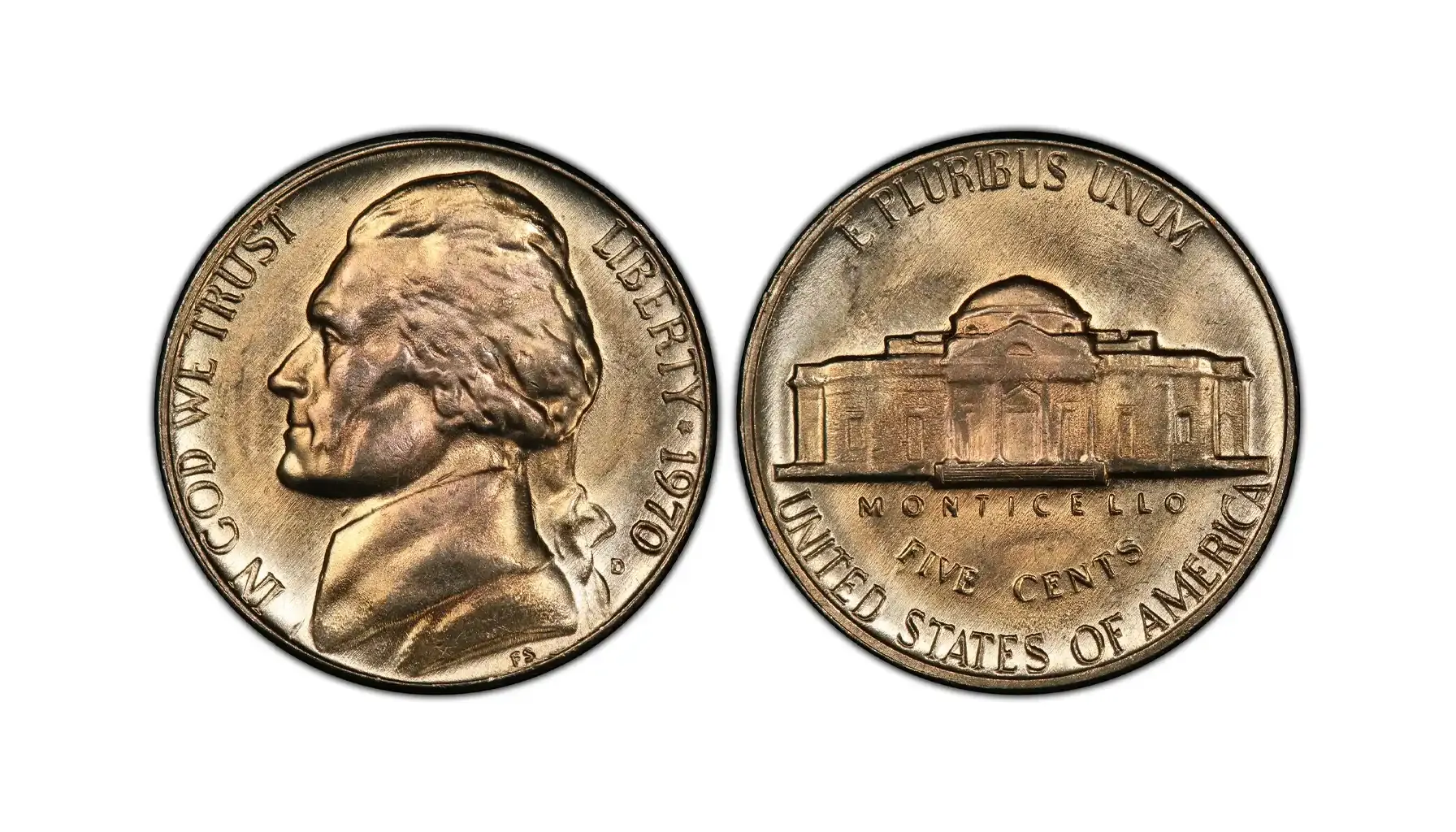
Understanding the Value of 1970 Nickels
The 1970 nickel worth varies significantly depending on its condition and mint origin. Most used nickels from this year are still worth their face value, but collectors may be interested in uncirculated or proof coins more. These higher-grade coins are usually kept in their original mint sets or found in change with only light wear.
Knowing the 1970 nickel value today requires more than just looking at the coin’s date. Key indicators include surface luster, strike quality, and the presence of Full Steps on Monticello. Services like PCGS and NGC grade coins MS65 or higher, and they can sell for $5 to $50. Proof coins that are labeled Deep Cameo can sell for more than $100.
Mint Mark | Coin Type | Condition | Estimated Value Range |
No Mint | Circulation | Circulated | $0.05 – $0.25 |
D | Circulation | MS60 – MS65 | $1 – $12 |
D | Circulation | MS66+ w/FS | $25 – $150+ |
S | Proof | Cameo | $3 – $10 |
S | Proof | Deep Cameo | $15 – $100+ |
If you're asking how much is a 1970 nickel worth, the answer depends on those factors—and more. And when it comes to the San Francisco issue, you may wonder, is a 1970 S nickel worth anything? The answer is yes, especially if it’s a high-grade proof or contains a recognized mint error.
The 1970 S Nickel and Its Varieties
The 1970 S nickel stands out for its quality and limited production, making it a favorite among serious collectors. The San Francisco Mint mostly made these coins as proof coins, which means that the dies and blanks used to make them were specially cleaned to make the surfaces smooth and shiny. Several varieties of 1970-S nickels exist, each with its own collector demand. Common categories include:
Standard proof, which still offers impressive quality despite being widely available.
Cameo proof, which shows frosted design elements contrasted by glossy fields.
Deep Cameo (DCAM) proofs, which have strong frost and deep reflection, are prized by grading services.
Doubled die varieties, which can exhibit visible duplication in lettering or detail — and often command higher premiums.
As for the 1970 S nickel value, it largely depends on the variety and overall grade. While standard proofs may only bring in a few dollars, coins with Deep Cameo or Cameo designations in PR67 or higher can reach $20 to $100 or more. If you're wondering how much is a 1970 S nickel worth, the answer depends on a combination of rarity, condition, and demand.
Even more impressive are doubled die proofs, which are difficult to find and often sell for significantly higher amounts depending on the severity of the error. It's also worth noting that the 1970 S proof nickel value increases sharply with better preservation and third-party certification, especially from PCGS or NGC.
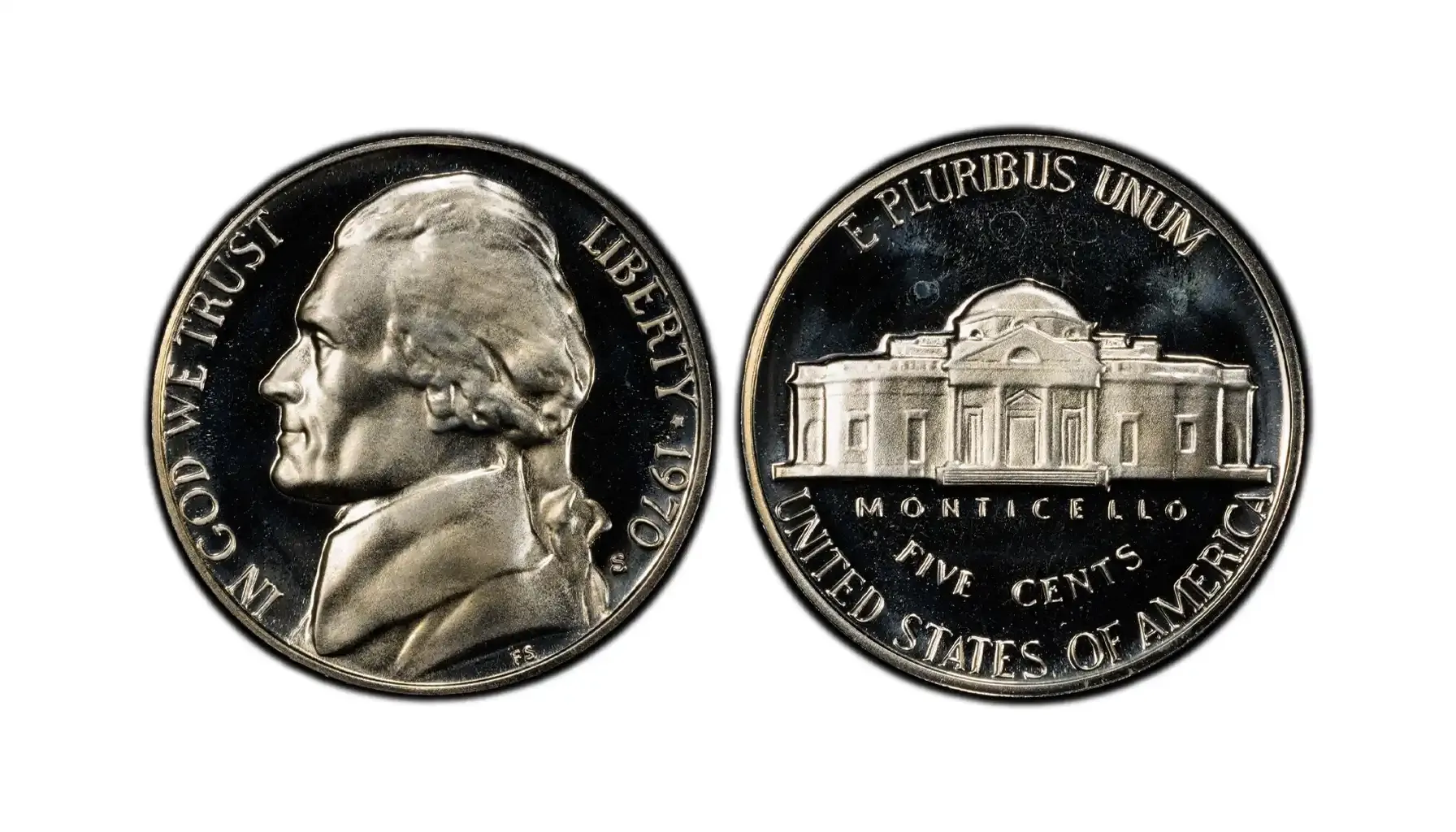
The 1970 D Nickel and Its Collectible Varieties
Among Jefferson nickels, the 1970 D nickel stands out for its abundance in circulation and the range of conditions in which it appears today. Struck at the Denver Mint, this coin features the “D” mint mark to the right of Jefferson’s portrait.
Most of these coins are still easy to find in poor condition, but some types can be worth a lot, especially if they have been kept in good shape or have strong strike qualities. Collectors often look for coins that say "Full Steps on Monticello," which means that the coin has fine details and is more desirable. For insights into valuable Jefferson nickels, including those with Full Steps, you might find this list of 87 Nickels Worth Money by Year helpful.
In higher uncirculated grades, the 1970 D nickel value can jump considerably. A coin that is perfectly centered, has no flaws, a nice shine, and clear Full Steps can fetch prices that are many times its market value. Some of the most expensive pieces have grades of MS66 or better and can fetch more than $100.
The 1970 D jefferson nickel is also known for minor die variations and strike inconsistencies that, when certified by grading agencies, may appeal to variety specialists. Because of its widespread production, the 1970 D mint mark remains a popular focus for new collectors looking to build an affordable yet interesting collection of modern U.S. nickels.
Condition | Strike Designation | Estimated Value Range |
Circulated | Standard | $0.05 – $0.25 |
Uncirculated MS60–MS64 | No Full Steps | $1 – $8 |
Uncirculated MS65–MS66 | Full Steps (FS) | $15 – $100+ |
MS67+ | Full Steps (FS) — Top Tier | $150 – $400+ |
Whether you're looking for a sharp uncirculated example or a certified Full Steps variety, the 1970-D is a great entry point into serious nickel collecting.
Errors and Rare Varieties in 1970 Nickels
While most nickels from this year follow a standard design and strike, a number of notable mistakes slipped through the minting process — and today, these coins are in high demand. One of the most talked-about varieties is the 1970 S nickel error, where the coin shows clear doubling on the obverse lettering, especially around “IN GOD WE TRUST” and “LIBERTY.” These are known as doubled die errors and are considered quite valuable.
Similarly, collectors have found examples of the 1970 D nickel error, which can present as off-center strikes, die breaks, or even clipped planchets. These striking flaws, though accidental, are precisely what make the coins so desirable — because every error tells a different story.
Another highly collectible variety is the 1970 nickel error known as the “no mint mark.” Since most 1970 nickels were struck either in Denver or San Francisco, they should carry a “D” or “S” mint mark. However, a small number of coins appear to be missing a mint mark altogether. These so-called 1970 nickel no mint mark errors may have occurred due to a filled die — when grease or debris blocks the area where the mint mark should be. Though unintentional, these coins are considered scarce and are often priced well above face value depending on their condition and eye appeal.
Beyond these more common mistakes lies the 1970 S nickel small date, a subtle but important variety for serious collectors. This version features a smaller, tighter date font compared to the standard 1970-S proof coin.
It may take a trained eye to spot it, but once identified, it can add significant value to a collection — particularly when combined with a Deep Cameo or Full Steps designation. All of these 1970 nickel errors not only offer a glimpse into minting history but also give everyday coins the potential to become standout collectibles.
Collecting Tips and Summary of 1970 Nickel Value
For both new and seasoned collectors, the 1970 Jefferson nickel offers an affordable and rewarding coin to pursue. While most examples remain common, understanding the finer details — like mint marks, strike quality, and potential errors — can help you separate the everyday coins from the more valuable ones.
If you're wondering how much is a 1970 nickel worth, the answer often depends on subtle differences like condition and origin. For example, the 1970 S jefferson nickel value can vary widely depending on whether it’s a regular proof, a Deep Cameo, or a coin with a recognized minting error. To preserve your finds, always handle them by the edges, avoid cleaning, and consider using protective holders or certified slabs for higher-value pieces.
One of the most appealing aspects of collecting these coins is the range of price points. Meanwhile, the 1970 copper nickel composition — 75% copper and 25% nickel — gives the coin durability but little intrinsic metal value.
Some used coins are only worth their face value, but error, proof, or uncirculated coins can fetch anywhere from a few dollars to several hundred dollars, based on how rare they are and how good their state is. It's not just about making money when you collect 1970 nickels. It's also about finding out the stories behind your pocket change, like you can do in the 1970 Quarter Value market.
Frequently Asked Questions
What is the value of a 1970 nickel with no mint mark?
Most 1970 nickels without a mint mark were struck in Philadelphia. In circulated condition, these coins are generally worth only face value — about 5 cents. However, if the coin is uncirculated or shows signs of a mint error, the value of a 1970 nickel without a mint mark could increase to a few dollars depending on grade and demand.
Are 1970 nickels made of copper or another metal?
The 1970 copper nickel composition is standard for Jefferson nickels minted during that time: 75% copper and 25% nickel. Despite common confusion, there are no solid copper nickels from 1970. If your nickel 1970 appears a different color, it’s likely due to toning or environmental damage rather than a metal variation.
Is a 1970 S proof nickel rare or valuable?
While the 1970 S proof nickel is not considered rare due to relatively high mintage, it can still be valuable. Coins with Deep Cameo contrast and high grades (PR67 or above) are the most desirable. So, is a 1970 S nickel rare? Not typically — but exceptional specimens with proof designations or errors can be worth a premium.
Are there any 1970 nickel errors worth money today?
Yes, several error types from 1970 are known to carry added value. These include double dies, off-center strikes, and clipped planchets. For example, 1970 D nickel errors can include noticeable misalignments, while the 1970 S nickel error list with pictures often highlights doubled dies on the obverse. A complete 1970 nickel error list is helpful when inspecting your collection for hidden gems.

